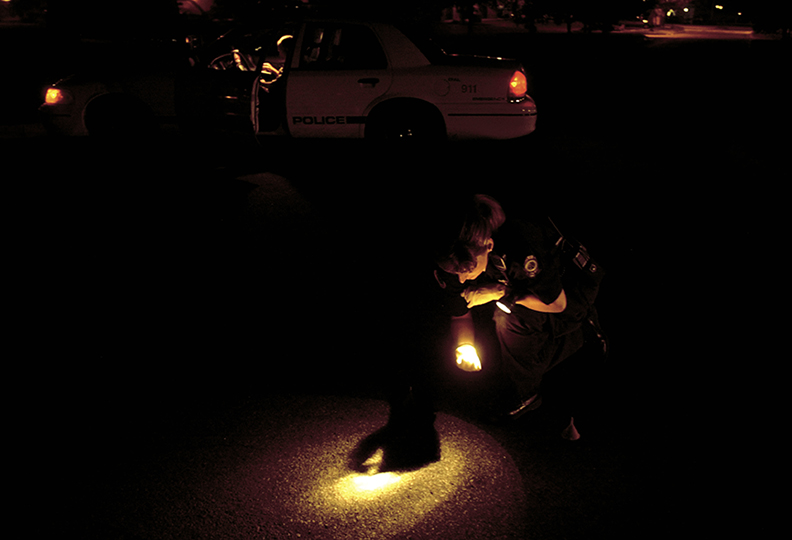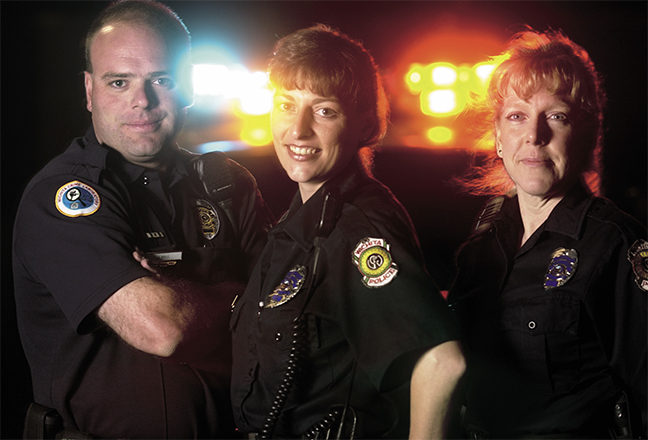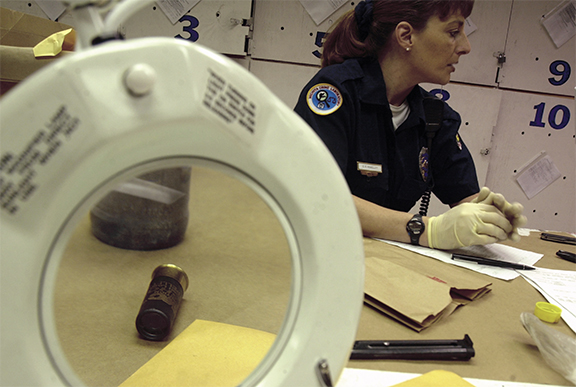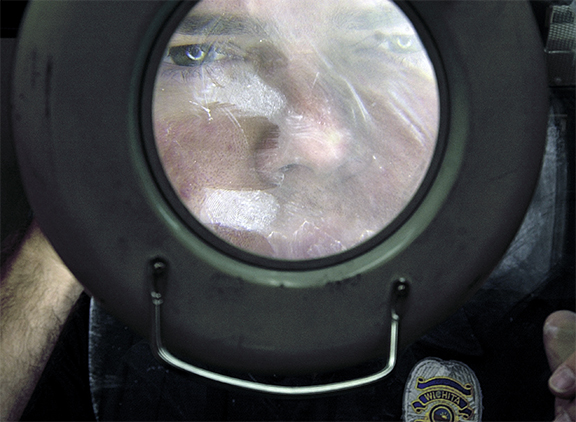
Every crime scene — like the double helix of DNA or the whorls and ridges of a fingerprint — is unique. But it takes a practiced, patient eye to catch all the differences, not to mention the perps.
Yellow crime-scene tape marks the boundary of a world we think we know, thanks to a slew of popular TV police dramas, “CSI: Crime Scene Investigation,” for example, and “CSI: Miami,” “NYPD Blue” and the battery of Law and Orders.
After all, we’re familiar with this realm’s jargon and recognize many of its tools of trade, everything from the basic process of dusting for fingerprints to newer aids, such as Luminol and DNA testing. But despite the spike of interest in police work in general and crime scene investigation in particular, we actually know little about the real work of the men and women who’ve chosen careers in the technical services bureaus of police departments across the country.
For one thing, beyond that yellow line lies a topsy-turvy, inside-out world where the invisible needs to be made visible and the relative value of things plummets or soars in a weird inverse relationship to their normal-world status. A strand of human hair lost in a dusty corner is of no consequence in our world; it might be the single most important find in the other.
Like Alice in a not-so-wonderful Wonderland, the professionals working on the other side of that yellow line have to see things differently.
“It’s not glamorous, like TV shows sometimes make it seem,” says Sherry Renollet ’99, a two-year CSI veteran of the Wichita Police Department’s technical services bureau. Renollet works the third shift, 10:30 p.m. through 6:30 a.m. “There’s a lot of gore — and a lot of smells.”
There’s also, on occasion, boredom. “The worst part of this job,” reports Scott Pike ’90/95, director of the WPD’s crime lab, “is the slow times. It can get really boring. I like to be involved in the action. The best part of the job is that there’s always something different going on. We get to — we have to — use our brains.”

three of 11 WPD crime scene investigators — and three
of nine Wichita State graduates who work for the Wichita
police’s technical services bureau.
Investigating crime scenes is meticulous, methodical work. “You can’t assume anything,” says Jamal Bara ’86/92, who works third shift. “You have to pay attention to everything and let the evidence tell you what happened.”
For every hour Bara spends photographing, measuring and collecting physical evidence on the scene, another hour of her on-duty time will be taken up with processing evidence and writing reports back at the crime lab.
That one-to-one ratio has proven to be a standard for CSI investigators, who are civilians with no powers of arrest and who do not carry guns. Their work days can also include testifying in court.
Some of them visit local schools to talk about their profession with students. And, depending on their individual talents and inclinations, a few of them may even be found doing a bit of light construction.
“I built this wall,” reports Andrew “Drew” Maul ’93, an investigator who works CSI’s first shift, 6:30 a.m. to 2:30 p.m. He is pointing to a new dividing wall in the public entranceway to the Wichita police’s Property and Evidence building, a dilapidated structure not far from downtown that houses tens of thousands of items seized during criminal investigations.
While cars and other vehicles are kept at another site, everything from drugs, guns and knives, to a huge, white, bow-tied Teddy Bear reside in this warehouse, with eight full-time employees tracking every item’s coming and going.
Crime scene investigators and P&E staff are counted among the 30 professionals who work in WPD's technical services bureau — one of four bureaus that make up the investigations division. The bureau is divided into two sections: P&E and the crime lab.
Assigned to the lab are 11 investigators and three CSI supervisors as well as two latent print examiners, a photographer, a photo technician and two forensic scientists, who conduct their testing for drug and crimes-against-persons cases at the Sedgwick County Regional Forensic Science Center. Renollet, who calls the entire WPD “one big family,” says, “We take care of each other.”
Sixth-Floor Crime Lab
The lab occupies part of the sixth floor of the City Building downtown. It is not like the high-tech centers featured on television shows, nor does it offer the breadth of services that the Sedgwick County Regional Forensic Science Center does. But gritty and relatively low-tech as it is, it gets the job done.
Currently undergoing renovation, the crime lab includes areas for such specialized equipment as a Super Glue Fuming Tank for obtaining fingerprint impressions, a photo lab with an MP4 camera for photographing fingerprints, an evidence-processing room plus supervisors’ offices and work space for the investigators.

one of the approximately 2,000 crime scenes that are
investigated by CSI experts each year.
With its soothing blue-gray walls and its five IBM computer work stations, the investigators’ headquarters looks like any comfortable office setting — until the visitor’s eye spots books with titles such as Testifying in Court, The Essentials of Forensic Medicine, Gray’s Anatomy and Outline of Death Investigation or focuses on the crime scene photographs strewn for easy study along a desktop.
Blood, Guts and the Methodology of Death
“What heat does to bodies is not pretty,” Maul reports, as he picks up a photo from an old homicide case. The victim had been discovered in the enclosed back of his black pickup truck six days after death — during one of the hottest stretches of summer. Maul shakes his head and refocuses his attention on the present.
Today, his case load numbers one homicide, seven burglaries and an attempted rape, and he is busy with paperwork. Although every investigator on every shift is qualified to perform all aspects of the job, autopsies and bank robberies are informally considered to be specialties of those who work first shift, which Maul does.
“I’ve been to somewhere between 50 and 60 autopsies,” he says. “At all times, everyone involved is very respectful of the dead. But we do have to look at things from a certain angle. One medical examiner once told me, ‘This person is now a piece of evidence.’ It’s true — bodies can tell you a lot, if you know what to look for. But you’ve got to understand the methodology of death.”
Maul, a devoted husband and father who’s worked with the WPD since 1995, has seen death in many of its most gruesome guises: shotgun blasts to the head, stabbings and mutilations, drownings and fires, airplane crashes. Yet, like many of his colleagues, he says the most unsettling cases are not necessarily the bloodiest or the goriest.
Crimes and deaths involving children are the most troubling ones to him. “I had a SIDS case years ago. I still remember the young police officer who was there when I arrived. He and his wife had a newborn of their own at home, and he had tears in his eyes. I remember his tears.”
Crime lab director Pike, who previously worked for 12 years in fire investigation and code enforcement, comments, “We deal in death almost every day. The best way to get a handle on that is to focus on the key things — on the evidence, on explaining the death or solving the crime.”

WPD’s crime lab, located on the sixth floor of the City
Building. Later, he swabs a handgun for DNA, which will
be tested at the Sedgwick County Regional Forensic
Science Center. Crime scene investigators work homicides,
suicides, robberies, rapes, assaults, drive-by shootings,
burglaries, auto thefts and any other crime for which a
specialized skill is needed to photograph, measure, collect
or analyze physical evidence. One WSU graduate who’s
been on the job for 20 years is CSI second-shift supervisor
Patric Cunningham ’75. Other Shocker grads working CSI
include Jerry Malter ’76, Donna Elson ’93 and Mary Ayers
’71, a forensic chemist.
And those never-ending pursuits, Maul stresses, take teamwork, not only among CSI colleagues, but within the entire law-enforcement community.
Using a particular quadruple murder case as the backdrop for his example, he says, “The officers put the grabs on ’em, but it’ll be forensics evidence — fingerprints, DNA — that’ll put them away forever.”
At a work station near Maul’s is taped one of those little slips of paper from fortune cookies; the words on it say, “The law sometimes sleeps, but never dies.”
As CSI’s first shift runs into the second and the second into the third, it’s obvious this is one arm of the law that never sleeps.
In the Dark of Night
Some two hours into her third-shift watch, Renollet is called to the scene of a no-injury shooting in northeast Wichita.
During the drive there, she displays one of the lesser-known talents that investigators seem to develop on the job: an eerie ability to hear and respond to multiple forms of communication almost simultaneously — and despite the constant clattering of metal shelves loaded with equipment and supplies in the back of the dark blue CSI van.
Renollet easily carries on a conversation and tracks the information coming to her over the radio that is always with her while on the job.
“On third shift,” she reports, “we often get the heinous stuff. And if it’s a full moon, you can count on chaos.” This late-August night only a few stars break through the haze of urban lights; no moon is in sight. “I love this job. It’s tedious work, but finding the clues and coming up with the solution — it’s great.” She adds that not much surprises her after two years in CSI.
Like Maul, the cases that bother her the most involve children. But the horrendous things this mother of a 2-year-old son has seen haven’t dimmed her overall view of people. “I have not lost faith in people’s goodness,” she says. “But I am more aware of what can happen.”
At the scene, Wichita police officers have set reflective cones over bullet fragments and shell casings that litter the parking lot. A car sporting a new bullet hole stands ready for Renollet’s attention. Taking a notepad, a camera and a fingerprinting kit with her, she goes to work. “You never know,” she says, “what piece of evidence is going to link something.”
In another part of the city, Bara, who holds an undergraduate degree in linguistics and a master’s degree in anthropology, is investigating the scene of a burglary.

prove the crux of a criminal investigation. Mindy
Johnson ’93, a latent print examiner, says the best part
of her job is “the thrill of matching a fingerprint to a
suspect.” Her work is made faster by the Automated
Fingerprint Identification System, a KBI computer
database of hundreds of thousands of prints. “To be
AFIS qualified,” Johnson explains, “a fingerprint has to
have at least eight points of identification. If it does, we
can sometimes match a print in minutes.”
The burglar has left a diverse set of clues for her to read: a footprint, a tire impression and pry-marks left by a screwdriver on the metal frame of the garage door through which the thief gained entrance. One of the officers on site helps her set up a tripod.
She photographs the tire track and footprint and then makes plaster casts of both. Turning her attention to the pried-open garage door, she uses an extruder gun filled with a putty-like form of silicon to lift imprints of the marks.
“See,” she says, pointing to the scratches, “we might be able to match these to the screwdriver that made them. Almost everything leaves some kind of distinguishing mark.”
Renollet, Bara and the other members of their CSI and law-enforcement family continue to work through the night — as they collectively do every night and day.
Their work behind that yellow crime-scene tape requires them to sift through the worst of being human. But the payoff is big: They know however tedious, however gruesome the work is, it’s nothing less than the groundwork for justice.





